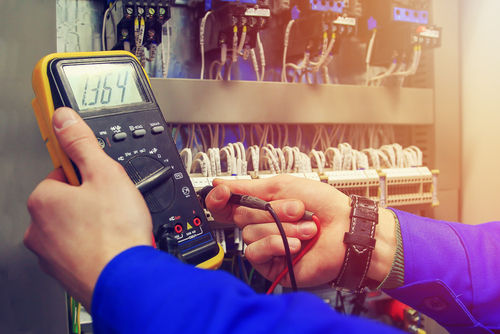What does maintenance actually mean?
Maintenance is generally understood to mean all measures that are necessary to maintain the technical units of a system. The aim is to maintain the functional condition of a technical unit or - in the event of a previous failure - to return it to an operational state. According to DIN 31051, there are four different basic maintenance measures:
Maintenance
This includes all measures that contribute to ensuring the target condition or to delaying the progressive degree of wear - such as changing an oil filter.
Inspection
The term inspection covers all activities that serve to determine and assess the actual condition, including determining the causes of wear and tear and deriving the necessary consequences for future use (e.g. measuring the exhaust gas temperature).
Repair
Repair measures ensure a return to a functional condition. The level of this state is the same as before a failure, i.e. without improvements (e.g. replacement of a component in the same design).
Improvement
The improvement includes all measures to increase the functional safety of a machine without changing the function required of it (e.g. by changing the design of the motor control wiring).


What are the objectives of maintenance?
All the basic measures mentioned above serve to achieve the primary maintenance objectives listed below:
- Security
- Availability
- Reliability
- Value retention
The goal of safety means that the Plant itself must not pose any danger. This requires, in particular, the maintenance instructions specified by the system manufacturer, which guarantee the above-mentioned target state. A Plant is available if it can (re)start operation at any time can. Various maintenance measures ensure that the Plant can be returned to an operational state at any time. can be transferred. Plant operation that is as (permanently) trouble-free as possible is described by the goal of reliability . Finally, by pursuing value retention , a high residual life expectancy of the Plants are ensured.
Find out which functions of the ADASMA maintenance software optimally support you in pursuing your goals.
The maintenance strategies
Time and performance-based maintenance strategy
In the context of time-based and performance-based maintenance, the Maintenance measures are carried out at regular intervals. The interval-like distances can be, for example from the classic The number of hours depends on the calendar date, the number of system operating hours or the distance traveled. The Maintenance measures are thus carried out deliberately and before the functionality of a technical unit is lost, so that a maximum system availability is guaranteed. A classic application example is the replacement of the oil filter on a Gas engine after 2,000 operating hours.
Condition-based maintenance strategy
Based on the assumption that failures are not random or sudden occur, but develop over a period of time, are analyzed as part of the condition-based maintenance strategy. diagnostics are carried out regularly to determine maintenance requirements. Inspections are used to check the condition (e.g. B. wear) of the technical unit is checked, evaluated and, depending on the result, a maintenance measure is ordered.
Compared to the time and performance-based strategy, this has led to the As a result, components are only replaced when their technical condition requires it and not after one year. early control interval. In this way, cost potentials can be exploited and, at the same time, the failure and consequential losses can be minimized. as far as possible. The replacement of a cylinder head on a combustion engine can be cited as a practical example, whose wear is determined using a valve residue measurement. The replacement then depends on the respective condition.
Failure-based maintenance strategy
For maintenance measures that cannot be planned, the failure-based maintenance strategy. Maintenance measures are only carried out in response to the loss of functional and operational reliability. performance of a technical unit. By consistently dispensing with intermediate maintenance, only the Part replaced, which is actually defective. In contrast to the two preventative strategies explained above, the This means that malfunctions and damage are deliberately accepted and inspection and spare parts resources are saved as a result.
Nevertheless, there is a risk of unforeseeable consequential damage to of the overall system, which may outweigh the resources saved depending on the extent of the damage. Furthermore, this Maintenance strategy long downtimes in combination with reduced reliability of the technical machines.
Which maintenance strategy is the best?
In conclusion, it can be said that there is no universal maintenance strategy. The purpose pursued with a strategy depends too much on external factors. The strategy selection should be significantly influenced by the conditions of the technical Plant. In the case of technically complex systems, the strategy even depends on the respective components of the Plant (see the practical examples given).
In addition, the mentality and maintenance policy of the plant operators and the relevance of the technical systems for the overall system (e.g. a public power supply from a CHP plant) are also included in the overall assessment. As a result, only a combination of the various maintenance strategies leads to the best possible approach and the associated economic optimum.
What tasks does maintenance software perform?
Maintenance planner for interval-based maintenance strategies
Our ADASMA maintenance and servicing software reminds you The integrated maintenance planner reminds you in good time of performance or time-based maintenance intervals. From annual maintenance to to rule maintenance, for example. Fully automatic maintenance reminders are sent every 2,000 operating hours (depending on the degree of utilization). generated within the ticket system. Do both apply to you? No problem. Simply create the condition that at least is serviced once a year or at least every 4,000 operating hours. Depending on which event occurs first, you will receive a corresponding maintenance ticket. A graphic display visualizes the time remaining until the next maintenance. With ADASMA you have all due maintenance dates under control at all times.
Complete system history for condition-based analyses
The clearly laid out system history shows you a complete overview of all work carried out on the Plant. In addition, you can view measured value curves in order to monitor the current status of the Plant as a whole or individual components. The system also informs you of reported measurement logs. of the service technicians where the upper and lower limits were not reached. This allows you to react at an early stage and initiate appropriate measures.
ADASMA as maintenance software
for maintenance, servicing and service companies
In addition to the aspects mentioned above, ADASMA offers you many other useful functions that make your day-to-day work as a maintenance and repair company much easier. This includes, for example a structured and clear asset management function. You can also carry out helpful evaluations on the dashboard based on the system data. These serve as a sound basis for important strategic decisions.
ADASMA provides an intuitive planning board for office-based service planners, which can be used to coordinate service technicians in the field in a time-saving and efficient manner - including route optimization. The range of functions is rounded off by a high-performance and easy-to-use service technician app. This puts you in a position to fully digitize your entire maintenance process and exploit all the potential offered by today's technologies.
The ADASMA maintenance software is industry-independent and is primarily aimed at maintenance and service companies that carry out service work on their customers' properties. Find out here in which areas ADASMA is already being used and where its operation is particularly suitable.
